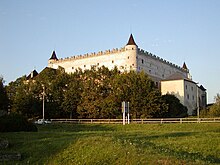Zvolen
| Zvolen | ||
|---|---|---|
| coat of arms | map | |

|
|
|
| Basic data | ||
| State : | Slovakia | |
| Kraj : | Banskobystrický kraj | |
| Okres : | Zvolen | |
| Region : | Pohrony | |
| Area : | 98.727 km² | |
| Residents : | 42,167 (Dec. 31, 2019) | |
| Population density : | 427 inhabitants per km² | |
| Height : | 293 m nm | |
| Postal code : | 960 01 | |
| Telephone code : | 0 45 | |
| Geographic location : | 48 ° 35 ' N , 19 ° 8' E | |
| License plate : | ZV | |
| Kód obce : | 518158 | |
| structure | ||
| Community type : | city | |
| Urban area structure: | 6 districts | |
| Administration (as of November 2018) | ||
| Mayor : | Lenka Balkovičová | |
| Address: | Mestský úrad Zvolen Námestie slobody 22 96061 Zvolen |
|
| Website: | www.zvolen.sk | |
| Statistics information on statistics.sk | ||
Zvolen (German Altsohl , Hungarian Zólyom - older also Ózólyom , Latin. Veterosolium ) is a city in central Slovakia . It is located at the mouth of the Slatina river in the Hron / Gran and gives a district its name.
history
The city was mentioned for the first time in 1135 and is one of the oldest prehistoric settlements in Slovakia, because important trade routes have crossed at the strategically favorable location of the city since ancient times. Only ruins are left of the town's original watchtower, the so-called Pustý hrad (literally "desert castle") on the opposite bank of the town.
Under Bela IV. Zvolen received city rights in 1243 and extensive privileges under King Ladislaus IV .
In the second half of the 14th century (1370–1382) King Ludwig I of Hungary had a mighty hunting lodge ( Altsohl Castle ) built as a summer residence in this Upper Hungarian town . The Diet of 1378 took place near the city, where his daughter Hedwig was married to the Polish King Władysław II Jagiełło .
The expanded and connected fortifications of the castle-like castle and the city withstood the repeated attacks by the Turks , but were conquered by the rebels during the uprising of Francis II Rákóczi (class uprising, around 1700).
With the railway connection in 1871 , the city developed into a modern transport hub and center of industry. The largest brickworks in Slovakia is located here, as well as a university of forestry and timber industry, a theater and museums.
During the Slovak National Uprising , the city played an important role; an armored train set up west of the castle reminds of this. In 1950 the Technical University of Zvolen was founded, making Zvolen a university town .
City structure
The city comprises the following 6 districts:
- Kráľová (German Königsberg; incorporated in 1980)
- Lukové (incorporated in 1976)
- Môťová (German Matthiasdorf; incorporated in 1946)
- Neresnica
- Zolná (incorporated in 1976)
- Zvolen
The Zvolenské Podhradie district was incorporated as early as 1888 and does not constitute a separate administrative unit of the city.
population
Ethnic composition
- Slovaks: 95.87%
- Czechs: 1.20%
- Roma: 0.94%
- Hungary: 0.50%
- Ukrainians: 0.05%
- German: 0.03%
religion
- Roman Catholic: 52.46%
- Non-denominational: 26.43%
- Evangelical: 15.04%
- Greek Catholic: 0.46%
- Orthodox: 0.14%
Attractions
-
historical city center with:
- Market square, lined with late Gothic , Renaissance and Baroque houses , plus that
- Altsohl Castle , built in place of a medieval sacred building.
- Sankt Elisabeth Church, built 1381–1390, redesigned several times, with preserved Renaissance furnishings
- City museum with local history exhibition
- Remains of the city fortifications from the 16th century
Town twinning
Since 2007, Zvolen has been a member of the European city association Douzelage , each of which includes cities from one country in the European Union .
Other partner cities are:
| city | country |
|---|---|
|
Imatra |
|
|
Prachatice , Prachatitz |
|
|
Rivne , Rovno |
|
|
Tótkomlós |
|
|
Zwoleń |
|
sons and daughters of the town
- Bálint Balassa (1554–1594), poet
- Karol Beck (* 1982), tennis player
- Jozef Cíger-Hronský (1896–1960), writer
- Joseph Kozáček (1807–1877), theologian, founding member and chairman of Matica slovenská
- Milan Lasica (* 1940), humorist
- Ján Lašák (* 1979), ice hockey goalkeeper
- Vladimír Mečiar (* 1942), politician
- Anna Petrušová (* 1984), soccer player
- Andrej Podkonický (* 1978), ice hockey player
- Filip Polášek (* 1985), tennis player
- Jana Roziaková (* 1986), football player
- Samuel Rožnay (1787–1850), pastor and writer
- Dmitri Schitnikow (* 1989), Russian handball player
- Zuzana Tomčíková (* 1988), ice hockey goalkeeper
See also
Web links
Individual evidence
- ↑ a b Partnerské mestá. Retrieved October 27, 2019 .







